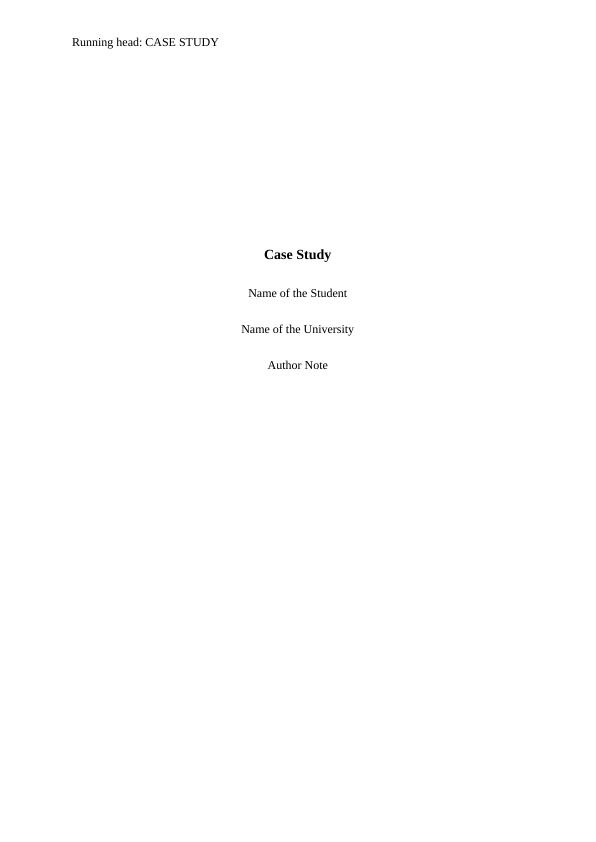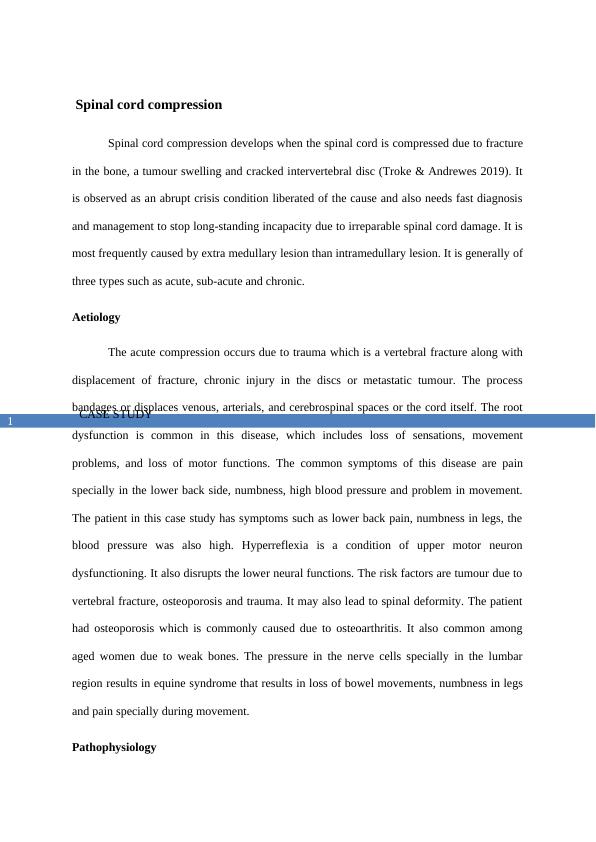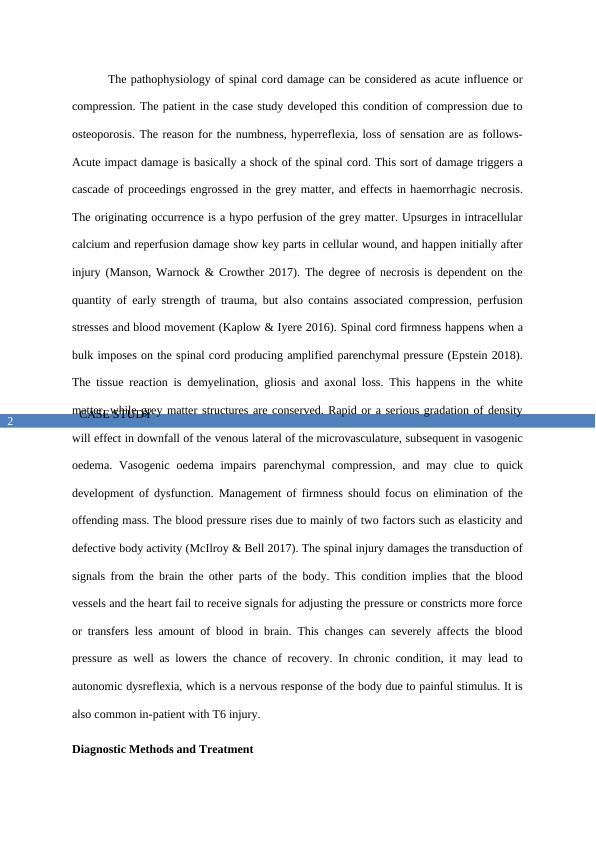Case Study - Spinal Cord Compression
Create a concept map and provide a written explanation for a case-study scenario on spinal cord compression.
7 Pages1528 Words18 Views
Added on 2022-09-15
Case Study - Spinal Cord Compression
Create a concept map and provide a written explanation for a case-study scenario on spinal cord compression.
Added on 2022-09-15
ShareRelated Documents
Running head: CASE STUDY
Case Study
Name of the Student
Name of the University
Author Note
Case Study
Name of the Student
Name of the University
Author Note

CASE STUDY
1
Spinal cord compression
Spinal cord compression develops when the spinal cord is compressed due to fracture
in the bone, a tumour swelling and cracked intervertebral disc (Troke & Andrewes 2019). It
is observed as an abrupt crisis condition liberated of the cause and also needs fast diagnosis
and management to stop long-standing incapacity due to irreparable spinal cord damage. It is
most frequently caused by extra medullary lesion than intramedullary lesion. It is generally of
three types such as acute, sub-acute and chronic.
Aetiology
The acute compression occurs due to trauma which is a vertebral fracture along with
displacement of fracture, chronic injury in the discs or metastatic tumour. The process
bandages or displaces venous, arterials, and cerebrospinal spaces or the cord itself. The root
dysfunction is common in this disease, which includes loss of sensations, movement
problems, and loss of motor functions. The common symptoms of this disease are pain
specially in the lower back side, numbness, high blood pressure and problem in movement.
The patient in this case study has symptoms such as lower back pain, numbness in legs, the
blood pressure was also high. Hyperreflexia is a condition of upper motor neuron
dysfunctioning. It also disrupts the lower neural functions. The risk factors are tumour due to
vertebral fracture, osteoporosis and trauma. It may also lead to spinal deformity. The patient
had osteoporosis which is commonly caused due to osteoarthritis. It also common among
aged women due to weak bones. The pressure in the nerve cells specially in the lumbar
region results in equine syndrome that results in loss of bowel movements, numbness in legs
and pain specially during movement.
Pathophysiology
1
Spinal cord compression
Spinal cord compression develops when the spinal cord is compressed due to fracture
in the bone, a tumour swelling and cracked intervertebral disc (Troke & Andrewes 2019). It
is observed as an abrupt crisis condition liberated of the cause and also needs fast diagnosis
and management to stop long-standing incapacity due to irreparable spinal cord damage. It is
most frequently caused by extra medullary lesion than intramedullary lesion. It is generally of
three types such as acute, sub-acute and chronic.
Aetiology
The acute compression occurs due to trauma which is a vertebral fracture along with
displacement of fracture, chronic injury in the discs or metastatic tumour. The process
bandages or displaces venous, arterials, and cerebrospinal spaces or the cord itself. The root
dysfunction is common in this disease, which includes loss of sensations, movement
problems, and loss of motor functions. The common symptoms of this disease are pain
specially in the lower back side, numbness, high blood pressure and problem in movement.
The patient in this case study has symptoms such as lower back pain, numbness in legs, the
blood pressure was also high. Hyperreflexia is a condition of upper motor neuron
dysfunctioning. It also disrupts the lower neural functions. The risk factors are tumour due to
vertebral fracture, osteoporosis and trauma. It may also lead to spinal deformity. The patient
had osteoporosis which is commonly caused due to osteoarthritis. It also common among
aged women due to weak bones. The pressure in the nerve cells specially in the lumbar
region results in equine syndrome that results in loss of bowel movements, numbness in legs
and pain specially during movement.
Pathophysiology

CASE STUDY
2
The pathophysiology of spinal cord damage can be considered as acute influence or
compression. The patient in the case study developed this condition of compression due to
osteoporosis. The reason for the numbness, hyperreflexia, loss of sensation are as follows-
Acute impact damage is basically a shock of the spinal cord. This sort of damage triggers a
cascade of proceedings engrossed in the grey matter, and effects in haemorrhagic necrosis.
The originating occurrence is a hypo perfusion of the grey matter. Upsurges in intracellular
calcium and reperfusion damage show key parts in cellular wound, and happen initially after
injury (Manson, Warnock & Crowther 2017). The degree of necrosis is dependent on the
quantity of early strength of trauma, but also contains associated compression, perfusion
stresses and blood movement (Kaplow & Iyere 2016). Spinal cord firmness happens when a
bulk imposes on the spinal cord producing amplified parenchymal pressure (Epstein 2018).
The tissue reaction is demyelination, gliosis and axonal loss. This happens in the white
matter, while grey matter structures are conserved. Rapid or a serious gradation of density
will effect in downfall of the venous lateral of the microvasculature, subsequent in vasogenic
oedema. Vasogenic oedema impairs parenchymal compression, and may clue to quick
development of dysfunction. Management of firmness should focus on elimination of the
offending mass. The blood pressure rises due to mainly of two factors such as elasticity and
defective body activity (McIlroy & Bell 2017). The spinal injury damages the transduction of
signals from the brain the other parts of the body. This condition implies that the blood
vessels and the heart fail to receive signals for adjusting the pressure or constricts more force
or transfers less amount of blood in brain. This changes can severely affects the blood
pressure as well as lowers the chance of recovery. In chronic condition, it may lead to
autonomic dysreflexia, which is a nervous response of the body due to painful stimulus. It is
also common in-patient with T6 injury.
Diagnostic Methods and Treatment
2
The pathophysiology of spinal cord damage can be considered as acute influence or
compression. The patient in the case study developed this condition of compression due to
osteoporosis. The reason for the numbness, hyperreflexia, loss of sensation are as follows-
Acute impact damage is basically a shock of the spinal cord. This sort of damage triggers a
cascade of proceedings engrossed in the grey matter, and effects in haemorrhagic necrosis.
The originating occurrence is a hypo perfusion of the grey matter. Upsurges in intracellular
calcium and reperfusion damage show key parts in cellular wound, and happen initially after
injury (Manson, Warnock & Crowther 2017). The degree of necrosis is dependent on the
quantity of early strength of trauma, but also contains associated compression, perfusion
stresses and blood movement (Kaplow & Iyere 2016). Spinal cord firmness happens when a
bulk imposes on the spinal cord producing amplified parenchymal pressure (Epstein 2018).
The tissue reaction is demyelination, gliosis and axonal loss. This happens in the white
matter, while grey matter structures are conserved. Rapid or a serious gradation of density
will effect in downfall of the venous lateral of the microvasculature, subsequent in vasogenic
oedema. Vasogenic oedema impairs parenchymal compression, and may clue to quick
development of dysfunction. Management of firmness should focus on elimination of the
offending mass. The blood pressure rises due to mainly of two factors such as elasticity and
defective body activity (McIlroy & Bell 2017). The spinal injury damages the transduction of
signals from the brain the other parts of the body. This condition implies that the blood
vessels and the heart fail to receive signals for adjusting the pressure or constricts more force
or transfers less amount of blood in brain. This changes can severely affects the blood
pressure as well as lowers the chance of recovery. In chronic condition, it may lead to
autonomic dysreflexia, which is a nervous response of the body due to painful stimulus. It is
also common in-patient with T6 injury.
Diagnostic Methods and Treatment

End of preview
Want to access all the pages? Upload your documents or become a member.
Related Documents
Analysis of Spinal Cord Compression for Patient Wilmalg...
|3
|1347
|377
Nursing Assignment | Response to Questionslg...
|6
|1366
|20
